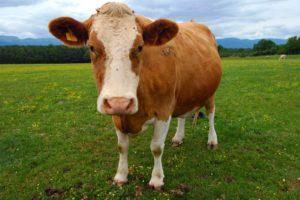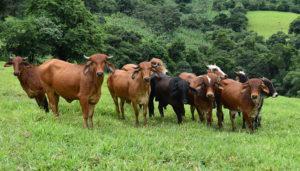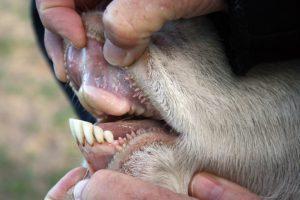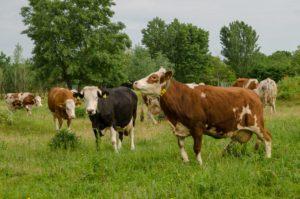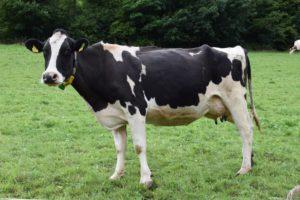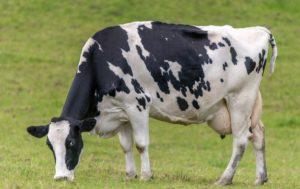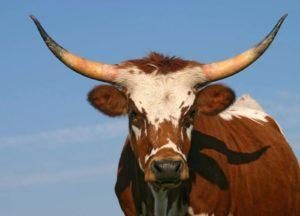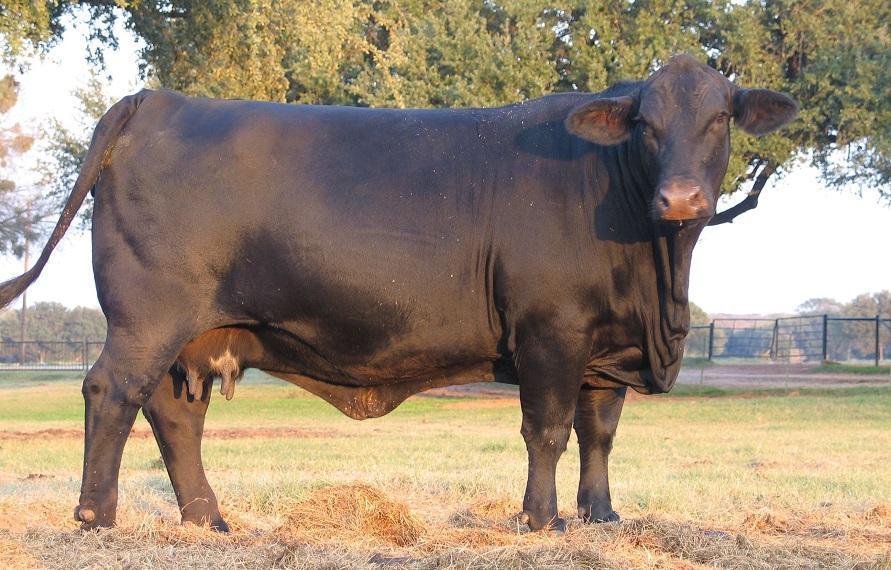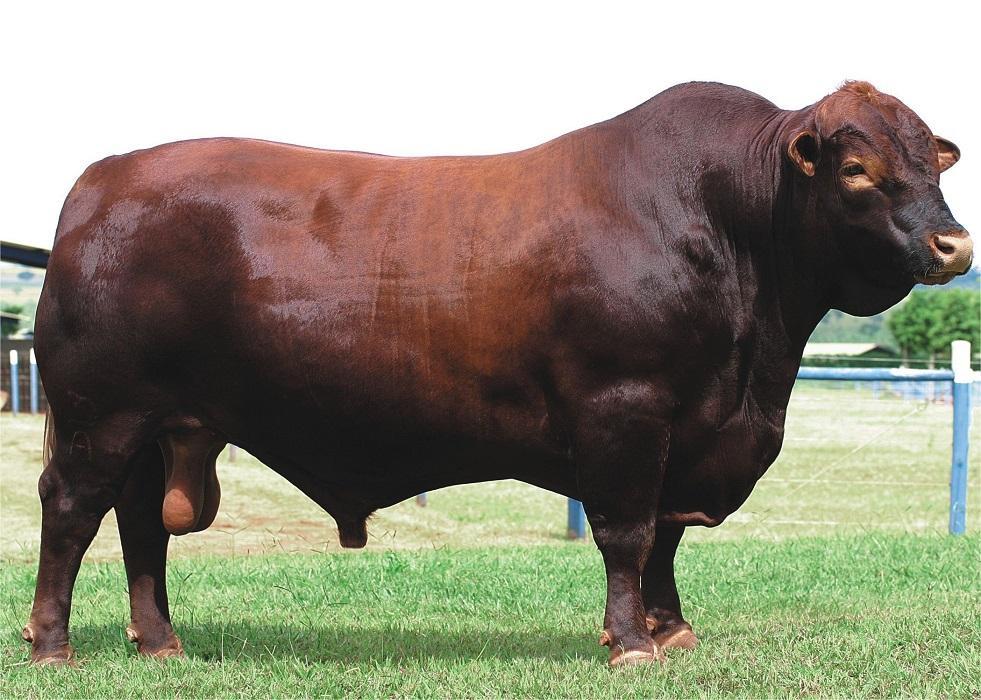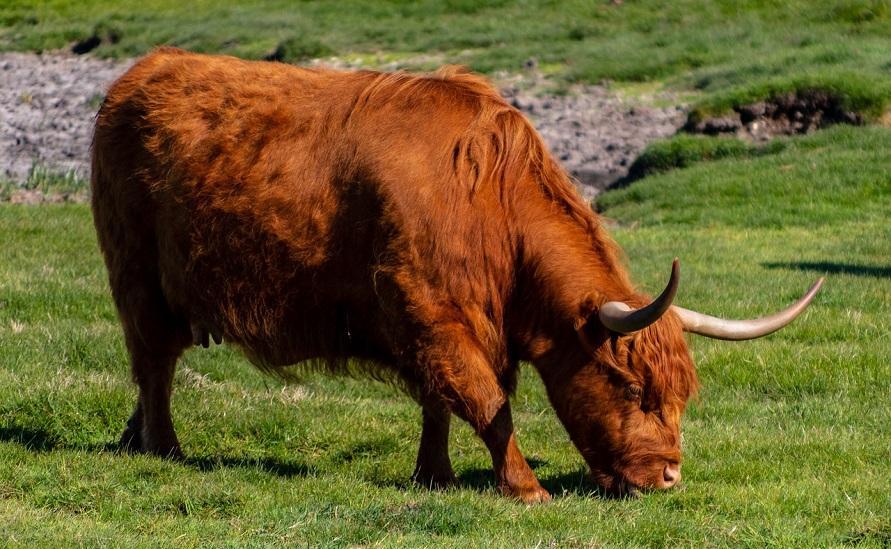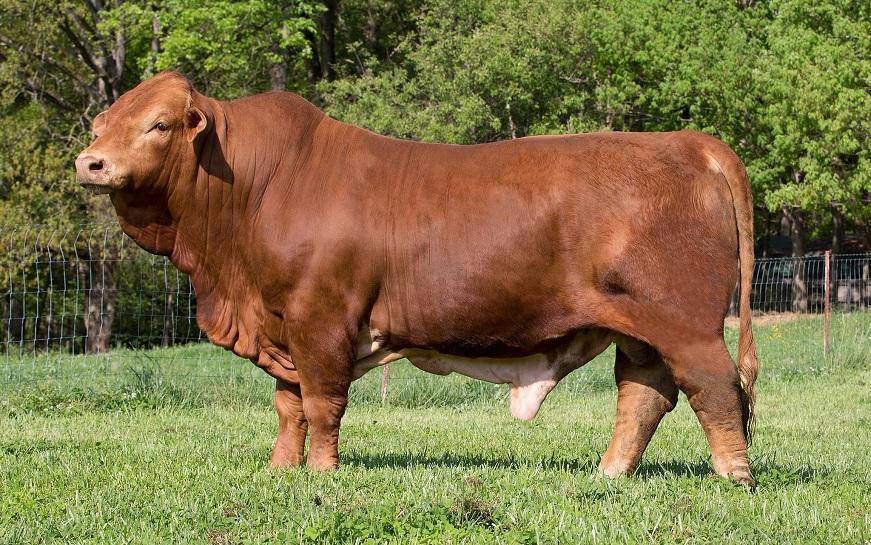Cattle
Cattle have been raised for years because of their vast utility. It is primarily bred for its meat, called beef or veal, and its milk, used to produce several dairy products like butter, cheese, and yogurt. Besides this, their hide is a crucial component in making leather, while their dung serves as a natural fertilizer and is also used for producing fuel.
The colloquially popular term cow refers to just the female cattle in taxonomy, while the males are called bulls. In daily verbiage, young cattle of both sexes, as well as castrated males, are also called ‘cows.’
The world cattle population in 2022 has been calculated to be about 940 million, according to USDA data. Cattle farming is prevalent in almost all countries, with India having the highest number of cows living there. In the United States, Texas has the highest number of cattle.
Types of Cattle Breeds by Purpose
There are hundreds of different breeds domesticated for various purposes, including:
 For Milk: Breeds that produce up to 9 gallons of milk per day. Examples: Holstein-Friesian, Jersey, Guernsey
For Milk: Breeds that produce up to 9 gallons of milk per day. Examples: Holstein-Friesian, Jersey, Guernsey
For Meat: Breeds that are grown primarily for meat. The more marbled the meat is, the higher the quality. Examples: Angus, Belted Galloway, Brahman
Dual Purpose: Breeds that are kept for both milk and meat. Examples: Maine-Anjou, South Devon, Irish Moiled.
As Draught Animals: Breeds that primarily work as draught animals, helping with agricultural work and carrying loads. Examples: Malvi, Zebu, Nagori
A to Z List of Cattle Breeds
A
- Aberdeen Angus
- Abergele
- Abigar
- Abondance
- Abyssinian Shorthorned Zebu
- Aceh
- Achham
- Adamawa
- Adaptaur (Taurus x Indicus)
- Afar
- Africangus (Taurus x Indicus)
- Afrikaner
- Agerolese
- Alambadi
- Alatau
- Albanian
- Albera
- Alderney
- Alentejana
- Aleutian wild cattle
- American Angus
- American Breed (Taurus x Indicus)
- American Brown Swiss
- American Milking Devon
- American White Park
- Amerifax
- Amrit Mahal
- Amsterdam Island cattle
- Anatolian Black
- Andalusian Black
- Angeln
- Ankole
- Ankole-Watusi
- Arado
- Argentine Criollo
- Armorican
- Arouquesa
- Asturian Mountain
- Asturian Valley
- Aubrac
- Aulie-Ata
- Aure et Saint-Girons
- Australian Braford (Taurus x Indicus)
- Australian Brangus (Taurus x Indicus)
- Australian Charbray (Taurus x Indicus)
- Australian Friesian Sahiwal (Taurus x Indicus)
- Australian Lowline
- Australian Milking Zebu (Taurus x Indicus)
- Ayrshire
B
- Bachaur cattle
- Baherie cattle
- Bakosi cattle
- Balancer
- Bali cattle
- Baoule
- Bargur cattle
- Barrosã
- Barzona (Taurus x Indicus)
- Bazadaise
- Beefalo (Taurus x American Bison)
- Beefmaster (Taurus x Indicus)
- Begayt
- Belgian Blue
- Belgian Red
- Belmont Red (Taurus x Indicus)
- Belted Galloway
- Berrenda cattle
- Betizu
- Bianca Modenese
- Blaarkop
- Blonde d’Aquitaine
- Blue Albion
- Blue Grey
- Bohuskulla
- Bonsmara (Taurus x Indicus)
- Boran
- Boškarin
- Braford (Taurus x Indicus)
- Brahman
- Brangus (Taurus x Indicus)
- Braunvieh
- Brava
- Bretonne Pie Noir
- British Friesian
- British White
- Brown Carpathian
- Brown Caucasian
- Brown Swiss
- Bue Lingo
- Burlina
- Buša cattle
- Bushuyev
- Butana cattle
C
- Cachena
- Camargue
- Campbell Island cattle
- Canadian Speckle Park
- Canadienne
- Canchim (Taurus x Indicus)
- Caracu
- Carinthian Blondvieh
- Carora
- Charolais
- Chianina
- Chillingham cattle
- Chinese Black Pied
- Cholistani Cattle
- Cika cattle
- Corriente
- Corsican cattle
- Crioulo Lageano
D
- Dajal cattle
- Dangi cattle
- Danish Jersey
- Danish Red
- Deoni
- Devon
- Dexter cattle
- Dhanni
- Doayo cattle
- Drakensberger
- Droughtmaster (Taurus x Indicus)
- Dwarf Lulu (Taurus x Indicus x Yak)
- Dølafe
E
- Eastern Finncattle
- Enderby Island cattle
- English Longhorn
- Ennstaler Bergscheck
- Estonian Red cattle
- Évolène cattle
F
- Finncattle
- Finnish Ayrshire
- Fjäll
- Fleckvieh
- Florida Cracker cattle
- Fogera
- French Simmental
- Fribourgeoise
G
- Galician Blond
- Galloway cattle
- Gangatiri
- Gaolao
- Garvonesa
- Gascon cattle
- Gelbvieh
- Georgian Mountain cattle
- German Angus
- German Black Pied cattle
- German Black Pied Dairy
- German Red Pied
- Gir
- Glamorgan cattle
- Glan cattle
- Gloucester
- Greek Shorthorn
- Greyman cattle (Taurus x Indicus)
- Guernsey cattle
- Guzerá
H
- Hallikar
- Hanwoo
- Hariana cattle
- Harzer Rotvieh
- Hays Converter
- Heck cattle
- Hereford
- Herens
- Highland cattle
- Hinterwald
- Holando-Argentino
- Holstein Friesian cattle
- Horro
- Hungarian Grey
I
- Iberian cattle
- Icelandic
- Illawarra cattle
- Indo-Brazilian
- Irish Moiled
- Istoben cattle
- Istrian cattle
J
- Jamaica Hope (Taurus x Indicus)
- Japanese Brown
- Jarmelista
- Javari cattle
- Jersey cattle
- Jutland cattle
K
- Kalmyk cattle
- Kangayam
- Kankrej
- Kasaragod Dwarf cattle
- Kathiawadi
- Kazakh Whiteheaded
- Kenana cattle
- Kenkatha cattle
- Kerry cattle
- Kherigarh
- Khillari cattle
- Kostroma cattle
- Krishna Valley cattle
- Kurgan cattle
- Kuri
L
- Lakenvelder cattle
- La Reina cattle
- Latvian Brown
- Latvian Danish Red
- Lebedyn
- Levantina
- Limia cattle
- Limousin
- Lincoln Red
- Lithuanian Red
- Lohani cattle
- Lourdais
- Lucerna cattle
- Luing
M
- Madura (Banteng x Indicus)
- Maine-Anjou
- Malnad Gidda
- Malvi
- Marchigiana
- Maremmana
- Marinhoa
- Maronesa
- Menorquina
- Mertolenga
- Meuse-Rhine-Issel
- Mewati
- Milking Shorthorn
- Minhota
- Mirandesa
- Monchina
- Mongolian
- Montbéliarde
- Munshiganj Cattle
- Murboden
- Murnau-Werdenfels
- Murray Grey
N
- N’Dama
- Nagori
- Nelore
- Nguni (Taurus x Indicus)
- Nimari
- Normande
- North Bengal Grey
- Northern Finncattle
- Norwegian Red
O
- Ongole
P
- Pajuna
- Palmera
- Pantaneiro
- Parthenaise
- Pasiega
- Pembroke
- Philippine Native
- Piedmontese cattle
- Pie Rouge des Plaines
- Pineywoods
- Pinzgauer
- Pirenaica
- Podolica
- Polish Red
- Polled Hereford
- Polled Shorthorn
- Poll Shorthorn
- Ponwar
- Preta
- Pulikulam
- Punganur
- Pustertaler Sprinzen
R
- Ramo Grande
- Randall
- Raramuri Criollo
- Rathi
- Rätisches Grauvieh
- Raya
- Red Angus
- Red Brangus (Taurus x Indicus)
- Red Chittagong
- Red Fulani (Taurus x Indicus)
- Red Gorbatov
- Red Holstein
- Red Kandhari
- Red Mingrelian
- Red Poll
- Red Sindhi
- Riggit Galloway
- Ringamåla
- Romagnola
- Romanian Bălţata
- Romosinuano
- Russian Black Pied
S
- Sahiwal
- Salers
- Sanga (Taurus x Indicus)
- Santa Gertrudis (Taurus x Indicus)
- Sayaguesa
- Selembu (Gaur x Indicus)
- Senepol (Taurus x Indicus)
- Shetland
- Shorthorn
- Sibi Bhagnari
- Siboney de Cuba (Taurus x Indicus)
- Simmental
- Siri
- South Devon
- Spanish Fighting Bull
- Speckle Park
- Square Meater
- Sussex
- Swedish Friesian
- Swedish Polled
- Swedish Red-and-White
- Swedish Red Pied
- Swedish Red Polled
T
- Tarentaise
- Tasmanian Grey
- Telemark
- Texas Longhorn
- Texon
- Tharparkar
- Tswana
- Tudanca
- Tuli
- Tulim (Taurus x Indicus)
- Tux-Zillertal
- Tyrol Grey
U
- Ukrainian Grey
- Umblachery
V
- Valdostana Castana
- Valdostana Pezzata Nera
- Valdostana Pezzata Rossa
- Väneko
- Vaynol
- Vechur
- Vianesa
- Volinian Beef
- Vorderwald
W
- Waguli
- Wangus (Taurus x Indicus)
- Welsh Black
- Western Finncattle
- Whitebred Shorthorn
- White Fulani
- White Park
Y
- Yakutian
- Yanbian
- Yurino
Z
- Zebu
- Żubroń (Taurus x European Bison)
History and Development
The domestication of the cow started around 10,500 years ago from wild aurochs (Bos primigenius), a huge wild cattle species that became extinct in 1627.
Cattle domestication happened in two major areas. The taurine (Bos taurus) line developed in the Near East, mainly in central Anatolia, Western Iran, and the Levant. On the other hand, the indicine (Bos taurus indicus) line developed in what is present-day Pakistan.
Though genetic studies show the two to have been domesticated independently, both forms derive their lineage from the auroch. The indicine cattle could be distinguished by their distinctive humps, which the taurine lacked.
From here, cattle began to spread globally. This was partly because of its usage as a standard form of currency (barter). Due to its value, people would trade cattle regularly. Being larger in size with greater utility, cattle held higher value than animals like goats or chickens.
Today, cattle are often raised by allowing their herds to graze on grasses and scrublands. This is considered an efficient way of utilizing land unsuitable for agriculture.
Most of them can survive on marshes, heath, moors, and semi-desert terrain. However, the degree of hardiness varies from one breed to another. Older breeds, like Jersey, have greater adaptability than many modern ones, which seem to lag behind in versatility. This is why smaller farmers often prefer these older breeds.
More on Cattle Breeds
Cattle by Characteristics
Cattle by Color
- Black And White Cows
- Black Cows
- Red Cows
- White Cows
Cattle by Country of Origin
- Indian Cows
- Japanese Cattle Breeds
- American Cattle Breeds
- French Cows
- Irish Cows
- British Cattle Breeds
- Cows From Africa
- South African Cattle

